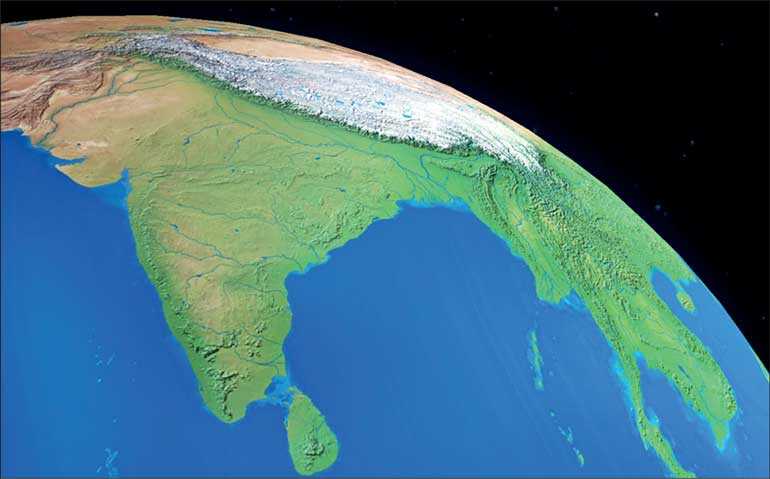Saturday Jan 11, 2025
Saturday Jan 11, 2025
Wednesday, 13 February 2019 00:00 - - {{hitsCtrl.values.hits}}

South Asian neighbourly ties
By Srimal Fernando and Mizly Nizar
India celebrated Republic Day on 26 January which commemorates the adoption of its Constitution in 1950. This

Constitution, still in force, gave India’s citizens the power to choose their own government established through a parliamentary model.
Separated by the Palk Strait, India’s neighbour Ceylon followed the same example and adopted its first Republican Constitution on 22 May 1972, subsequently changing the country’s name to Sri Lanka and establishing it as an independent republic.
Both countries at different times thus transitioned from being independent dominions in the Commonwealth of Nations and became republics with their own individual home grown constitutions. Presently both India and Sri Lanka still remain within the Commonwealth, sharing a common history and economic ties that form the building blocks to promote peace, democracy and development for all Commonwealth Nations.
As was with India, Sri Lanka’s first republican foreign policy too came with domestic aspirations. The common ground for both countries’ external policies was based on the principal of non-interference and neutrality. An independent foreign policy not dominated by external forces is important for South Asian countries to make independent decisions in order to protect and promote national as well as regional interests.
The republican foreign policy profiles adopted by both India and Sri Lanka were Eastward-oriented within a broad framework of non-alignment. The main thrust of Sri Lanka’s then Prime Minister Bandaranaike’s non-alignment policy, firmly based on national and regional interests, was her proposal to ensure that the Indian Ocean be made a zone of peace or nuclear free zone which was adopted by the United Nations in 1972.
If one were to analyse the relationship that existed between India and Sri Lanka since independence, it can be argued that the ties between the two countries became strong after Sri Lanka became a republic. Perhaps it could be held that it was the foreign policy strategy of Mrs. Bandaranaike in the 1970s that fortified the old bonds between the two nations. However, these links have been affected in the last three decades mainly due to the civil war between the Government of Sri Lanka and the Liberation Tigers of Tamil Ealam (LTTE) resulting in many ups and downs in bilateral ties that existed between the countries.
One of the key elements in reshaping the relationship and bridging the gap between both countries should be mainly based on the policy of non-interference which was in fact a key foreign policy principle of Indian Prime Minister Moraji Desai’s Government in 1977. Looking at bilateral links in the more recent past, one could argue that Sri Lanka’s foreign policy dynamics saw a sea change after 2014 since Narendra Modi became Prime Minster and implemented India’s Neighbourhood First policy.
Focusing on improving ties with its immediate neighbour, PM Modi visited Sri Lanka in 2015, the first Indian Prime

Minister to visit Lanka in 28 years. This was followed by another State visit in 2017, a key factor indicating the vast improvement in bilateral relations between the countries. During both visits, the Indian Head of State visited several parts of the island nation.
Modi’s Neighbourhood First policy has strengthened collaboration between the countries including India’s aid to Sri Lanka. During the last three years a large amount of aid has been a key turning point in bilateral relations. These include the construction of 50,000 houses mainly in the conflict affected areas which helped stabilise social conditions, the $ 800 million credit line for the Northern Railway and medical assistance through the islandwide ambulance service. These initiatives have worked wonders to win the hearts and minds of individuals in India’s neighbouring island nation.
To further strengthen the ties between the two neighbours, it will be useful if India could base its foreign policies on SAARC principles and Sri Lanka could also be flexible and accommodative in its external dynamics. Sri Lanka’s contemporary foreign policy stance with a more balanced outlook presents opportunities to further enhance links with India. The contentious issue that has been plaguing the countries since the last decade on fishing rights of Indian and Sri Lankan fishermen could be solved through regular dialogues.
While strengthening bilateral links, when Sri Lanka’s small island nation of 21 million people celebrates 71 years of Independence this year, the country has much to learn from India on the concept of unity in diversity.
India, home to 1.25 billion people with a complex amalgamation of various cultural identities, can be considered as a good example of how a deep sense of unity among its people keeps them bonded together despite it being an immensely multicultural society. Such a model is significant not only for Sri Lanka but also for other South Asian nations plagued by internal strife, to be emulated, to ensure that peace and prosperity prevails in the future for individual nations as well as for the region as a whole.
[Srimal Fernando is a Research scholar at Jindal School of International Affairs (JSIA), India and a Global editor of Diplomatic Society for South Africa. He won the 2018/2019 Best Journalist of the year award in South Africa. Mizly Nizar is a foreign policy analyst and a former visiting lecture at The Bandaranaike Centre for International Studies and the Open University of Sri Lanka.]